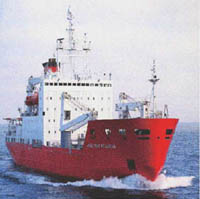Russia's mission to claim Arctic sea bed set to reach North Pole
An ambitious Russian expedition intended to symbolically claim a large swath of the Arctic for Moscow was within 100 miles of the North Pole Wednesday morning, and expected to reach the top of the world in the afternoon.

The atomic icebreaker Rossiya was ploughing through an unbroken sheet of multi-year ice, leading a Russian scientific research vessel, the Akademik Fedorov, toward the expedition's goal, the ITAR-Tass wire service reported. Visibility was reported good.
The voyage is part of the Kremlin's effort to bolster Russia's claims under international treaty to a large portion of the northern polar region, in an effort to expand both Russia's energy reserves and its global political clout.
At the pole, Russian scientists plan to dive in two mini-submarines beneath the pole to a depth of more than 4,000 meters, or more than 13,200 feet, and drop a metal capsule containing the Russian flag on the sea bed.
The symbolic gesture, along with scientific data being gathered by expedition scientists, is intended to prop up Moscow's claims to almost 1.2 million square kilometers (more than 460,000 square miles) of the Arctic shelf - which by some estimates may contain 10 billion tons of oil and gas deposits.
The expedition is part of an intense rivalry between Russia, the United States, Canada and other nations whose shores face the northern polar ocean for the Arctic's ice-bound riches.
About 100 scientists aboard the Akademik Fyodorov are looking for evidence that the Lomonosov Ridge - a 2,000 kilometer (1,240 mile) underwater mountain range that crosses the polar region - is a geologic extension of Russia, and therefore can be claimed by Russia under the U.N. Convention on the Law of the Sea.
In addition to dropping a titanium tube containing the Russian flag, the subs will collect specimens of Arctic flora and fauna and videotape the dives.
The most difficult part of the mission, scientists say, will be getting back precisely to the ice-free point of departure to avoid being trapped under a thick ice crust.
Denmark hopes to prove that the Lomonosov Ridge is an extension of the Danish territory of Greenland, not Russia. Canada, meanwhile, plans to spend US$7 billion (EUR 5.11 billion) to build and operate up to eight Arctic patrol ships in a bid to help protect its sovereignty.
The U.S. Congress is considering an $8.7 billion budget reauthorization bill for the U.S. Coast Guard, which includes $100 million to operate and maintain the nations three existing polar icebreakers, including two heavy "polar class" ships, the Polar Sea and the Polar Star, nearing the end of their useful lives.
The bill authorizes the Coast Guard to proceed with plans to construct two new vessels.
Subscribe to Pravda.Ru Telegram channel, Facebook, RSS!





